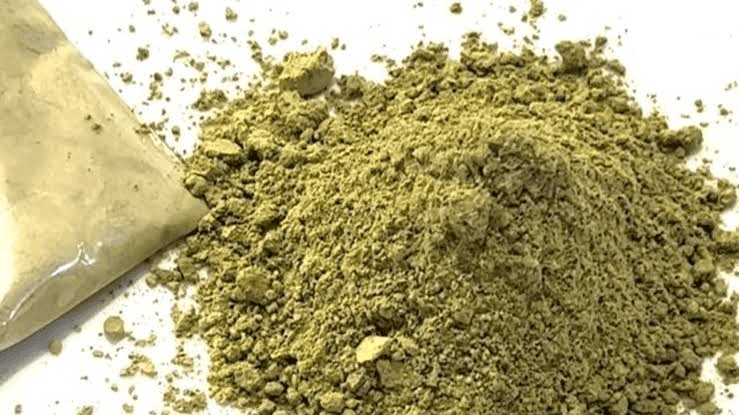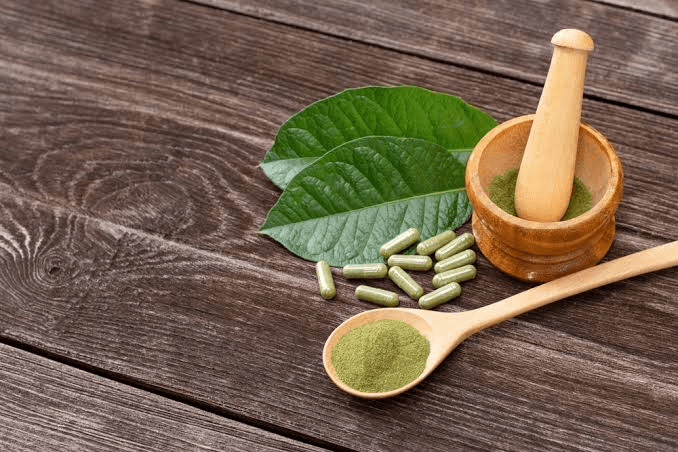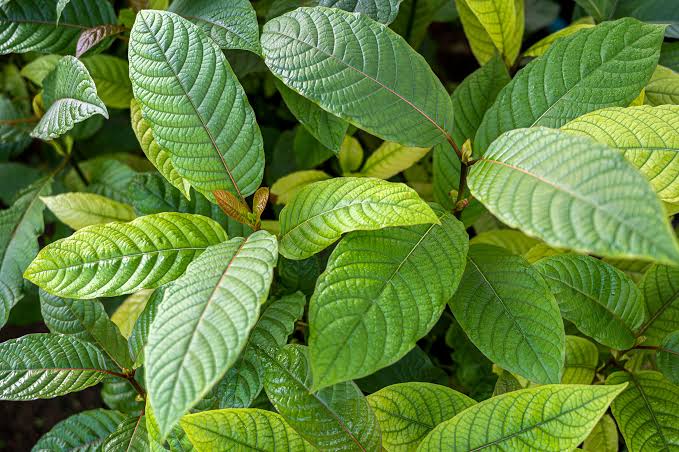Kratom, scientifically known as Mitragyna speciosa, is a tropical evergreen tree native to Southeast Asia, primarily in countries like Thailand, Malaysia, Indonesia, and Papua New Guinea.
The plant belongs to the Rubiaceae family, which also includes coffee. Kratom has gained attention worldwide for its unique properties and is often used for various purposes, including traditional medicine, recreational use, and as a dietary supplement.
The leaves of the Kratom tree contain active compounds known as alkaloids, with the most prominent one being mitragynine. These alkaloids are responsible for the plant’s effects.
Kratom’s effects can vary depending on the strain and dosage. It is often used for its stimulating and pain-relieving properties, which are similar to those of opioids. However, it’s important to note that Kratom has both stimulant and sedative effects, and its use can lead to dependence and potential adverse effects if not used responsibly.
Kratom is typically consumed by chewing the leaves, brewing them into a tea, or grinding them into a powder for use in capsules or as a powder to mix with liquids.
It has a long history of traditional use in Southeast Asia for its potential medicinal benefits, such as relieving pain, enhancing energy, and managing mood. However, its legal status and safety profile vary widely across different countries and regions, making it a subject of ongoing debate and research.
In recent years, Kratom has become a subject of controversy and regulatory scrutiny in various parts of the world due to concerns about its safety and potential for misuse.
As such, its use is a topic of ongoing research and debate, with proponents touting its potential therapeutic benefits and critics raising concerns about its safety and potential for addiction. As with any substance, it is essential to exercise caution and seek guidance from healthcare professionals when considering the use of Kratom.
The Botanical Description of Kratom
1. Leafy Evergreen Tree: Kratom (Mitragyna speciosa) is an evergreen tree known for its dense canopy of dark green, glossy leaves. It belongs to the Rubiaceae family and can reach heights of up to 82 feet (25 meters).
2. Smooth Bark: The tree has a smooth, grayish bark that develops a fissured texture as it matures. The bark plays a protective role for the inner woody stem.
3. Oval-Shaped Leaves: Kratom leaves are typically oval or elliptical in shape, with a pointed tip. They can grow to be around 7 inches (18 centimeters) long and 4 inches (10 centimeters) wide. The leaves’ deep green color is one of their distinguishing features.
4. Clusters of Flowers: Kratom trees produce clusters of small, white or yellow flowers that are unisexual, meaning they have either male or female reproductive organs. These flowers are not the primary source of Kratom.
5. Woody Stem: The central stem of the Kratom tree is sturdy and woody, providing structural support for the expansive canopy of leaves.
6. Prominent Veins: Kratom leaves have prominent veins, which are typically green, red, or white. The vein color is one of the factors that classify different Kratom varieties.
The Geographic Distribution of Kratom
1. Native to Southeast Asia: Kratom is native to Southeast Asia, primarily found in countries like Thailand, Indonesia, Malaysia, Myanmar (Burma), and Papua New Guinea. It thrives in the region’s tropical and subtropical climates.
2. Cultivation Worldwide: Due to the increasing global interest in Kratom, the tree is now cultivated in various countries outside its native range. This includes regions in North America, such as the United States.
3. Ideal Climates: Kratom prefers regions with high humidity, adequate rainfall, and well-drained, fertile soils. It thrives in temperatures between 75°F and 85°F (24°C to 30°C).
4. Rainforest Areas: In its natural habitat, Kratom is often found in rainforest areas and near riverbanks, where it benefits from the rich, moist soil and abundant sunlight.
5. Cross-Border Growth: In Southeast Asia, the Kratom tree’s natural distribution spans multiple countries, with varying Kratom strains found in different regions. This diversity is influenced by factors like climate and soil conditions.
The Chemical Composition of Kratom
1. Mitragynine: Mitragynine is the most abundant alkaloid found in Kratom leaves. It is responsible for many of Kratom’s effects, including pain relief and stimulation.
2. 7-Hydroxymitragynine: This alkaloid is another crucial component of Kratom. It has potent analgesic properties and is believed to be responsible for the sedative effects of certain Kratom strains.
3. Paynantheine: Paynantheine is an alkaloid that contributes to Kratom’s stimulating properties. It works in synergy with mitragynine to provide a balanced effect.
4. Speciociliatine: Speciociliatine is another alkaloid found in Kratom, although in smaller quantities. It is believed to have muscle relaxant properties and may enhance the pain-relieving effects.
5. Epicatechin: Epicatechin is a flavonoid found in Kratom leaves. It is known for its antioxidant properties and potential health benefits.
6. Rhynchophylline: Rhynchophylline is an alkaloid that is primarily found in the leaves of the Uncaria tomentosa plant. It is sometimes present in Kratom and may contribute to its effects.
The botanical description, geographic distribution, and chemical composition of Kratom is essential for anyone interested in this natural botanical substance.
The rich diversity of Kratom strains, each with unique characteristics, is a testament to its adaptability and complex chemical makeup. As Kratom continues to gain popularity, it’s important to appreciate the intricacies of this remarkable plant and its various uses and effects.
Read Also: 20 Medicinal Health Benefits of Phytolacca (Pokeweed)
The Medicinal Health Benefits Of Kratom (Mitragyna speciosa)

1. Pain Relief: Kratom is known for its natural analgesic properties. It can provide relief from various types of pain, including chronic pain, headaches, and muscle aches. The active alkaloids in Kratom, such as mitragynine and 7-hydroxymitragynine, interact with opioid receptors, offering pain-relieving effects.
2. Mood Enhancement: Kratom is valued for its ability to enhance mood and alleviate symptoms of depression and anxiety. It can promote a sense of well-being and mental clarity, making it a natural mood booster.
3. Energy and Stimulation: Certain Kratom strains, especially those with higher levels of mitragynine, can provide a stimulating effect. It can increase energy levels, focus, and alertness, which is beneficial for individuals dealing with fatigue or lethargy.
4. Stress and Anxiety Reduction: Kratom has anxiolytic properties, meaning it can help reduce stress and anxiety. It induces a sense of calm and relaxation, making it a natural remedy for those dealing with anxiety disorders.
5. Opiate Withdrawal Aid: Kratom has been used as a transitional aid by some individuals going through opiate withdrawal. Its ability to interact with opioid receptors can alleviate withdrawal symptoms, although this use is a subject of debate and should be approached with caution.
6. Immune System Support: Kratom contains various antioxidants, which can help strengthen the immune system and protect the body against free radicals and oxidative stress.
7. Cognitive Enhancement: Some Kratom users report improved cognitive function and memory enhancement. It may enhance mental clarity and concentration.
The Methods of Usage to Achieve the Provided Health Benefits Of Kratom (Mitragyna speciosa)
1. Traditional Consumption: In Southeast Asia, where Kratom is native, it is traditionally chewed or brewed into a tea. Chewing Kratom leaves can provide a mild stimulating effect, while Kratom tea offers a more balanced experience. These methods are used to achieve pain relief and enhance productivity.
2. Capsules and Powder: Kratom is available in the form of capsules and powder for oral consumption. Capsules provide a convenient and controlled way to take Kratom, while powder can be mixed into beverages or foods.
3. Tinctures and Extracts: Kratom tinctures and extracts are concentrated forms of Kratom. They are usually more potent and faster-acting. However, they should be used with caution due to their strength.
4. Smoking or Vaporizing: Although less common, some individuals choose to smoke or vaporize Kratom. This method provides a rapid onset of effects, but it is considered less efficient and not recommended due to potential health risks.
5. Mixing with Food or Drink: Kratom powder can be mixed with various foods or beverages, such as yogurt, smoothies, or juice, to mask its taste. This method is often preferred by those who find the taste of Kratom unpalatable.
6. Topical Application: In some regions, Kratom leaves are applied topically to the skin to alleviate pain and inflammation. However, this method is not as widespread as oral consumption.
The Side Effects Of Using Kratom Medicinal Plant
1. Nausea and Vomiting: Nausea and vomiting are common side effects, especially in individuals who take high doses of Kratom. These symptoms are typically temporary and can be reduced by adjusting the dosage.
2. Dizziness and Lightheadedness: Kratom can cause dizziness or lightheadedness, particularly when taken in large quantities. It’s important to use Kratom responsibly and avoid excessive doses.
3. Constipation: Kratom can lead to constipation in some users. Staying hydrated and maintaining a balanced diet can help mitigate this side effect.
4. Dependency and Tolerance: Prolonged and frequent use of Kratom can lead to dependency and tolerance, requiring higher doses to achieve the same effects. It’s essential to use Kratom in moderation.
5. Negative Interactions: Kratom can interact with other medications or substances, potentially causing adverse reactions. It’s advisable to consult a healthcare professional if you are taking other medications.
6. Cognitive Impairment: High doses of Kratom can lead to cognitive impairment and drowsiness. It’s essential to avoid activities that require focus and alertness when using Kratom in higher amounts.
Kratom, with its diverse range of health benefits, has gained popularity as a natural remedy for various issues, including pain, mood enhancement, and stress reduction.
However, it’s important to be aware of potential side effects and practice responsible usage. If you are considering using Kratom, it’s recommended to start with lower doses and gradually increase as needed while monitoring your body’s response. Always consult with a healthcare professional if you have any concerns or underlying health conditions.
Read Also: Definition and Establishment of Permanent Pastures
The Scientific Research and Studies of Kratom (Mitragyna speciosa)

1. Pain Management Studies: Numerous scientific studies have explored the potential of Kratom as a natural pain management solution. Research has focused on the interaction between Kratom alkaloids and opioid receptors, providing insights into its pain-relieving properties.
2. Addiction and Withdrawal Research: Some studies have investigated the use of Kratom in managing addiction and withdrawal from opioids. While this application is a subject of debate, research has explored the role of Kratom in reducing withdrawal symptoms.
3. Alkaloid Analysis: Scientific research has looked into the chemical composition of Kratom, particularly the presence and concentration of alkaloids like mitragynine and 7-hydroxymitragynine. These studies have contributed to our understanding of Kratom’s effects.
4. Cognitive Function Studies: Kratom’s potential effects on cognitive function have been a topic of research. Some studies have explored its impact on mental clarity, focus, and memory enhancement.
5. Safety and Toxicology: Research has been conducted to evaluate the safety and potential toxicological aspects of Kratom use. These studies have helped in identifying potential risks and safety measures.
6. Psychopharmacological Investigations: Scientific research has investigated the psychopharmacological properties of Kratom, including its effects on mood, anxiety, and stress reduction.
The Safety Precautions and Recommendations In Using Kratom (Mitragyna speciosa) Medicinal Plant
1. Dosage Regulation: It’s crucial to use Kratom responsibly and regulate the dosage. Starting with a lower dose and gradually increasing as needed can help minimize the risk of side effects.
2. Avoid Excessive Use: Excessive Kratom consumption can lead to undesirable side effects. It’s important to use Kratom in moderation to prevent nausea, dizziness, and other adverse reactions.
3. Hydration: Staying hydrated is essential when using Kratom, as it can sometimes lead to dry mouth and constipation. Drinking an adequate amount of water can help mitigate these effects.
4. Consultation with Healthcare Professionals: If you have underlying health conditions, are taking other medications, or are pregnant or breastfeeding, it’s advisable to consult with a healthcare professional before using Kratom.
5. Responsible Sourcing: Ensure that you source Kratom from reputable suppliers who adhere to quality and safety standards. This helps reduce the risk of contamination and ensures you receive a high-quality product.
6. Educate Yourself: Before using Kratom, it’s important to educate yourself about its effects, potential side effects, and appropriate usage. Understanding Kratom can help you make informed decisions.
FAQs About Kratom (Mitragyna speciosa) Medicinal Plant
1. Is Kratom legal to use?
Kratom’s legal status varies by country and region. In some places, it is legal for personal use, while in others, it is banned. It’s essential to research and understand the legal status in your area.
2. Can Kratom cause addiction?
Prolonged and frequent use of Kratom can lead to dependence and tolerance. While it is not classified as an opioid, it interacts with opioid receptors and should be used with caution.
3. What are the common side effects of Kratom?
Common side effects of Kratom may include nausea, vomiting, dizziness, constipation, and cognitive impairment at high doses.
4. Can Kratom be used for pain management?
Kratom is often used for pain management due to its analgesic properties. However, it should be used responsibly and under proper guidance.
5. Are there any potential drug interactions with Kratom?
Kratom can interact with other medications or substances, potentially leading to adverse reactions. It’s advisable to consult a healthcare professional if you are taking other medications.
6. How can I find a reliable source of Kratom?
To find a reliable source of Kratom, research and choose reputable suppliers who follow quality and safety standards. Reading user reviews and seeking recommendations can also help in identifying trustworthy sources.
Scientific research and safety precautions provide valuable insights into the use of Kratom as a medicinal plant. By understanding the scientific basis of its effects and adhering to safety guidelines, individuals can make informed decisions about its usage. It’s important to stay informed, use Kratom responsibly, and seek professional guidance when needed.
Read Also: Best Waste Materials Management Practices






